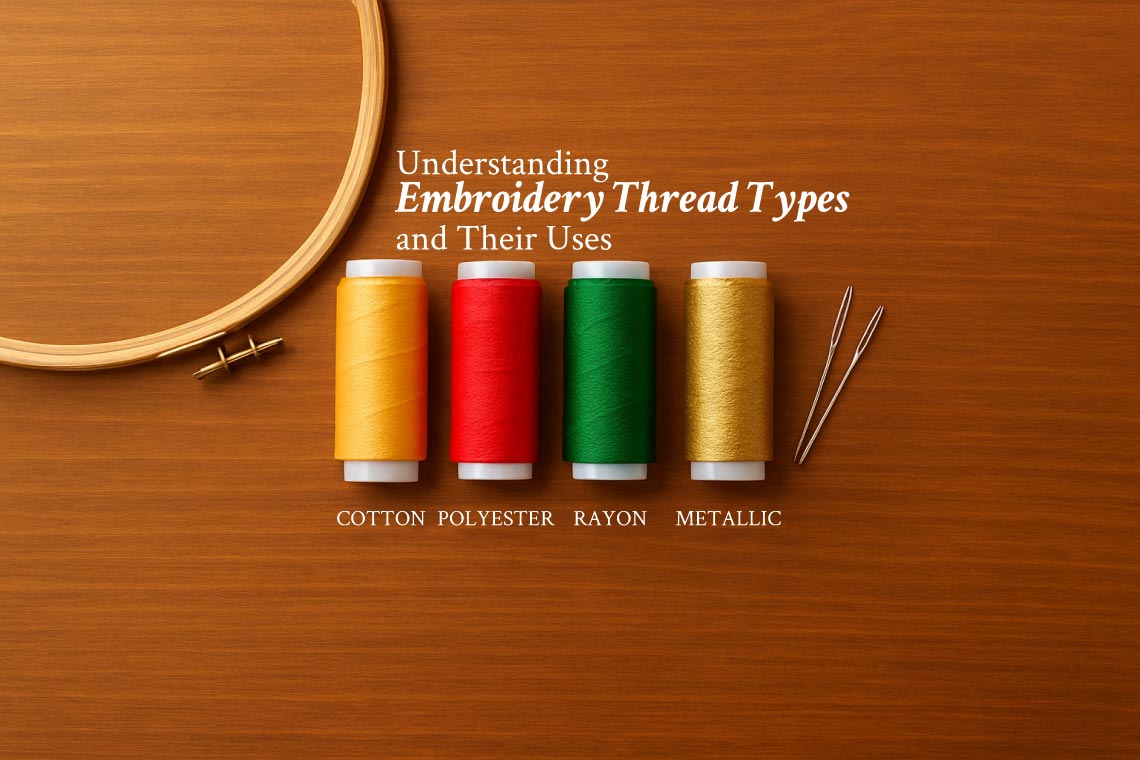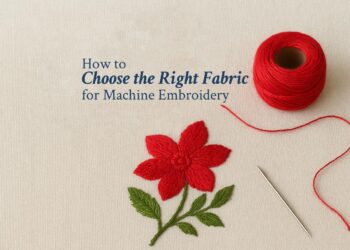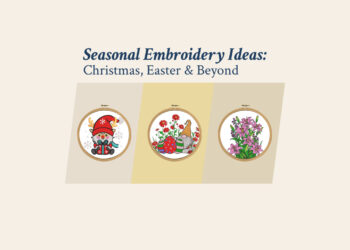Choosing the right embroidery thread is just as important as selecting your fabric or design. With countless options available, understanding the different embroidery thread types can make a big difference in the final look, texture, and durability of your work. Whether you’re hand stitching or using a machine, the right thread ensures vibrant colors, smooth stitching, and long-lasting results.
1. What Are Embroidery Threads?
Embroidery threads are specially designed yarns made for decorative stitching. Unlike regular sewing threads, they are softer, shinier, and often come in a variety of materials and finishes. Each type offers unique characteristics—some ideal for sheen and brightness, others perfect for strength and texture.
Understanding these thread differences helps you match the right material to your project, ensuring quality and consistency.
2. Common Embroidery Thread Types
1. Cotton Embroidery Thread
Cotton is a popular choice for traditional embroidery. It’s smooth, soft, and has a matte finish, making it perfect for detailed designs.
-
Best for: Hand embroidery, cross-stitch, and delicate fabrics.
-
Pros: Natural fibre, easy to work with, minimal sheen.
-
Cons: Can shrink or fade over time, less durable than synthetics.
2. Polyester Embroidery Thread
Polyester is widely used in machine embroidery thread because of its strength and sheen. It’s colorfast, resistant to fading, and can withstand frequent washing—ideal for garments and home décor items.
-
Best for: Machine embroidery, logos, uniforms, and outdoor items.
-
Pros: Durable, glossy finish, affordable.
-
Cons: Slightly less soft compared to rayon or cotton.
3. Rayon Embroidery Thread
Rayon threads are known for their incredible shine and smooth texture. They mimic the look of silk but are more affordable and easier to handle.
-
Best for: Decorative stitching, monograms, and lightweight fabrics.
-
Pros: Brilliant sheen, smooth stitching.
-
Cons: Less durable than polyester, not ideal for heavy washing.
4. Metallic Embroidery Thread
If you’re after a touch of sparkle, metallic embroidery thread adds shimmer and glamour to designs. Made from a metallic film wrapped around a nylon or polyester core, it’s perfect for festive or decorative projects.
-
Best for: Holiday designs, highlights, and ornamental stitching.
-
Pros: Eye-catching, reflective finish.
-
Cons: Can be tricky to stitch with; may fray if used too fast on machines.
5. Silk Embroidery Thread
Silk threads are luxurious and strong, with a natural shine that enhances fine embroidery work. Though expensive, they deliver unmatched beauty.
-
Best for: Heirloom embroidery, hand stitching, and high-end projects.
-
Pros: Elegant sheen, smooth texture.
-
Cons: Pricey and sensitive to moisture.
3. Polyester vs Cotton Embroidery Thread: Which Is Better?
The polyester vs cotton embroidery thread debate often depends on your project type.
| Feature | Polyester Thread | Cotton Thread |
|---|---|---|
| Durability | High – resists breakage | Moderate |
| Finish | Glossy | Matte |
| Maintenance | Fade-resistant, washable | Can fade or shrink |
| Best For | Machine embroidery, clothing | Hand embroidery, crafts |
In short, use polyester for practical, long-lasting embroidery and cotton for a soft, traditional look.
4. Tips for Choosing the Right Thread
-
Match thread to fabric type: Heavy fabrics need stronger threads like polyester, while delicate fabrics pair better with cotton or silk.
-
Consider thread weight: Finer threads create detailed work, while thicker ones add bold lines.
-
Check your machine compatibility: Some metallic or rayon threads require specific needle sizes.
-
Test before stitching: Always run a small test to check tension, color, and appearance.
5. Caring for Embroidery Threads
Proper thread storage extends their lifespan. Keep them in a cool, dry place away from sunlight to prevent fading. For machine embroidery thread, store spools upright and dust-free. If using metallic or rayon threads, consider using a thread net to reduce tangling and fraying.
Conclusion
Understanding the different embroidery thread types helps you make the right creative and practical choices for every project. From durable polyester to shimmering metallic and classic cotton threads, each material brings its unique charm to your work. The more you experiment, the better you’ll understand which thread type enhances your embroidery style.
FAQs
Q1: What is the best thread for machine embroidery?
A: Polyester thread is the most popular for machine embroidery due to its strength, colorfastness, and shine.
Q2: Can I use regular sewing thread for embroidery?
A: It’s not recommended, as sewing threads lack the sheen and flexibility of true embroidery threads.
Q3: How do I stop metallic threads from breaking?
A: Use a metallic needle, reduce stitching speed, and apply a thread net for smoother feeding.
Q4: Is rayon or polyester better for embroidery?
A: Rayon offers better shine, while polyester is more durable. Your choice depends on the project type and intended use.






